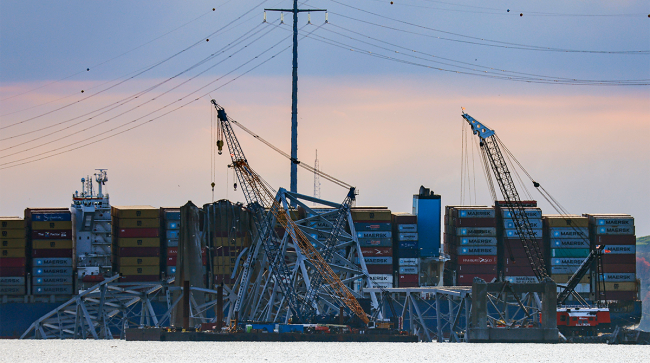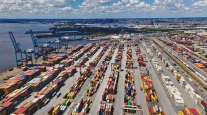Associated Press
Alternate Channel Opens at Baltimore Bridge Site

[Stay on top of transportation news: Get TTNews in your inbox.]
BALTIMORE — The U.S. Coast Guard has opened a temporary, alternate channel for commercially essential vessels near the fallen Francis Scott Key Bridge in Baltimore, part of a phased approach to opening the main channel leading to the vital port, officials said.
Crews have begun the complicated work of removing steel and concrete at the site of the bridge’s deadly collapse into the Patapsco River after a freighter hit it last week. On March 31, dive teams surveyed parts of the bridge and checked the ship, and workers in lifts used torches to cut above-water parts of the twisted steel superstructure.
Officials said the temporary channel on the northeast side of the main channel is open only to vessels that are helping with the cleanup effort. Officials earlier said it will have a controlling depth of 11 feet, a horizontal clearance of 264 feet and a vertical clearance of 96 feet, officials said. A video released March 31 showed the Coast Guard dropping buoys in the water.
“This will mark an important first step along the road to reopening the port of Baltimore,” Capt. David O’Connell, the federal on-scene coordinator of the response, said in a statement the night of March 31. “By opening this alternate route, we will support the flow of marine traffic into Baltimore.”
Under @POTUS's leadership, @SBAgov is prepared to support Baltimore and impacted communities as they grieve this terrible loss and begin to recover.
We're with you. — Isabel Casillas Guzman (@SBAIsabel) March 30, 2024
On April 1, the Small Business Administration is opening a center in Dundalk, Md., to help small businesses get loans to help them with losses caused by the disruption of the bridge collapse. Yvette Jeffery, a spokesperson for the agency’s disaster recovery office, said affected businesses can receive loans for as much as $2 million. She said the effects could range from supply chain challenges to decreased foot traffic in communities that depended heavily on the bridge.
And President Joe Biden will visit the site of the bridge collapse on April 5, White House press secretary Karine Jean-Pierre announced April 1. He will meet with state and local officials and get an “on-the-ground look” at federal response efforts, Jean-Pierre said.
The bridge fell as the crew of the cargo ship Dali lost power and control on March 26. They called in a mayday, which allowed just enough time for police to stop vehicles from getting on the bridge, but not enough time to get a crew of eight workers off the structure.
Two workers survived, two bodies were found in a submerged pickup, and four more men are presumed dead. Weather conditions and the tangled debris underwater have made it too dangerous for divers to search for their bodies.
The Dali is managed by Synergy Marine Group and owned by Grace Ocean Private Ltd. Danish shipping giant Maersk chartered the Dali, which was on its way out of port when it lost power and hit one of the bridge’s support columns.
The Port of Baltimore directly supports 8,000 workers. Maritime Administrator Admiral Ann Phillips and Deputy Assistant Secretary for Multimodal Freight Allison Dane Camden met with the director of the port and Tradepoint Atlantic to discuss the work ahead. pic.twitter.com/7vtcwJ43CD — U.S. Department of Transportation (@USDOT) March 30, 2024
Along with clearing the shipping channel to reopen the port, officials are trying to determine how to rebuild the major bridge, which was completed in 1977 and carried Interstate 695 around southeast Baltimore and was central to the city’s centuries of maritime culture.
Congress is expected to consider aid packages to help people who lose jobs or businesses because of the prolonged closure of the Port of Baltimore. The port handles more cars and farm equipment than any other U.S. facility.
— Contributing to this report were Associated Press journalists Mike Pesoli in Baltimore; Jeffrey Collins in Columbia, South Carolina; and Sarah Brumfield in Washington.
Want more news? Listen to today's daily briefing below or go here for more info:




